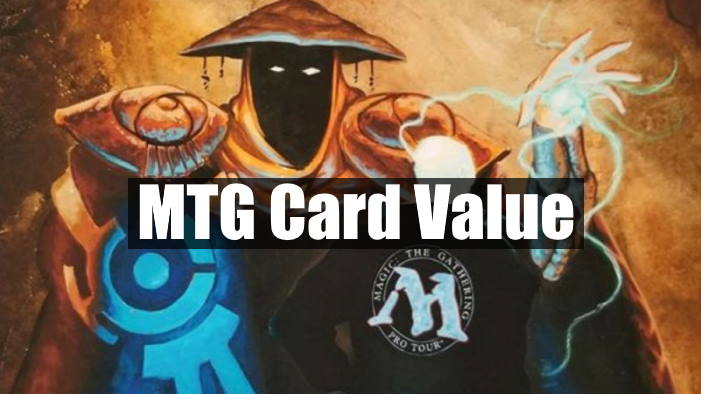This is a question without a simple answer. After all, some cards cost only a few cents; while others are upwards of half a million dollars. Furthermore, there are a few different points of view this question can be asked from. Perhaps the most common is when people who haven’t played in a long time revisit their old collections and discover they have cards sitting around that are potentially highly valuable. Such people may ask “how much are MTG cards worth and how do I know if mine is valuable?” Well, let’s find out.
Magic: The Gathering cards’ value varies quite drastically. For example, the average price for a single common card is around five to 10 cents. While the most expensive cards are worth hundreds of thousands of dollars. If you mash these two extremes together, buying one copy of every single card would cost you just over $6.50 per card.
Several factors determine a card’s value. Including things like what year the card was printed, its rarity, if it is foil, and what condition it’s in. As well as, things like how many copies of the card are in existence and if it’s possible for more copies of the card to be printed or not. This may seem like a lot, but once you understand a few key principles card value is pretty straightforward for the most part. Let’s take a closer look at things and how they change card worth.
Are Magic: The Gathering Cards Worth Money?
The answer is of course, yes. All cards are worth something, even if it is very little. Bulk commons that see little to no play sell for a few dollars per 1,000 cards. Things such as basic lands or creature tokens can usually fetch between $5 and $9 per 100. Everything has at least some value. With that said, the average common card costs around 10 cents.
Cards that see play in formats like Standard and Modern will usually have a higher price tag. As an example, let’s look at prices for the top 10 most played cards in Modern.
| Card Name | Average Price |
| Lightning Bolt | $0.75 |
| Engineered Explosives | $10 |
| Spell Pierce | $0.15 |
| Ragavan, Nimble Pilferer | $64 |
| Fury | $23 |
| Flusterstorm | $29 |
| Unlicenced Hearse | $12.04 |
| Mystical Dispute | $0.50 |
| Blood Moon | $9 |
| Teferi, Time Raveler | $15.45 |
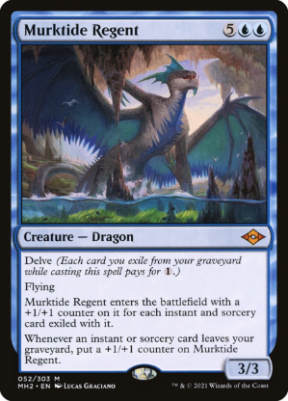
As you can see, format staples and highly played cards cost between $0.15 and $65. So, why is it that the most played card is less than a dollar while number 4 is over $60? This is due to the concept of supply and demand. Let me elaborate.
Lightning Bolt has been printed in 25 different sets. Each time it is reprinted more and more copies are put out into the world, which increases the available supply. While Ragavan, Nimble Pilferer has only been printed one time.
So, even though there is slightly less demand for Ragavan than Bolt, the difference in available supply on the market causes the former to be higher in price. This concept is very important when looking at card value. Therefore, we will touch more on it later.
What Causes Cards To Have Value?
As mentioned above, all cards have some value. However, in this section, we will be looking at cards with a more significant value. Furthermore, we will also look at what factors cause these cards to have, gain, or lose worth.
Supply And Demand
Cards that have a high price tag are all going to have two things in common to some degree. First, they are sought after in some way. This could be because of their power level from a gameplay perspective or their rarity from a collectability perspective. This is known as demand.
Second, there will be a cap of some sort on the number of a card that is on the market for buyers. This is usually due to a card having few printings. Again, a card like Lightning Bolt is a great example of how an excess of a card in print will cause even the most played cards to maintain a pretty low price. This is the “supply” side of the equation.
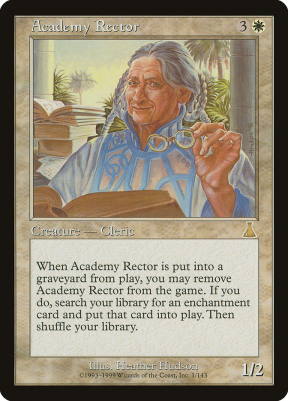
Cards that have playability and/or collectability and are also very scarce are the cards that usually have the highest value. This is a perfect place to segue into how reprints and what’s known as “the reserve list” greatly affect value.
The Reserve List And Reprints
The reserve list is a list of 572 cards that Wizards of the Coast vowed they would never reprint. This is quite significant when looking at what card worth is the most sustainable. First, let’s discuss how reprints affect prices.
Related: The MTG Reserved List Explained
Any card that isn’t on the reserve list can be reprinted at any time. When a card is reprinted there is a surge of new copies of the card becoming available, which increases the supply. This saturation of the market often causes the reprinted card to drop in price. Sometimes rather significantly.
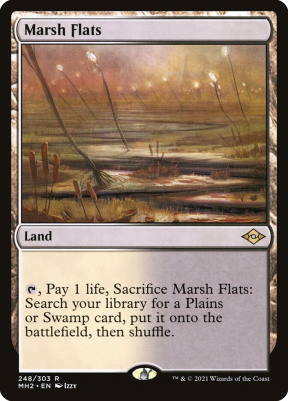
A somewhat recent example of this is Marsh Flats. Before its reprinting in Modern Horizons 2, Marsh Flats was around $40 per copy. As of the writing of this article, they cost around $11.
Cards on the reserve list enjoy the advantage of never having to worry about having their value reduced due to reprints. Furthermore, the fact that some of the game’s earliest and most historic cards are on the list, and therefore will never have another printing makes them scarce and highly collectible.
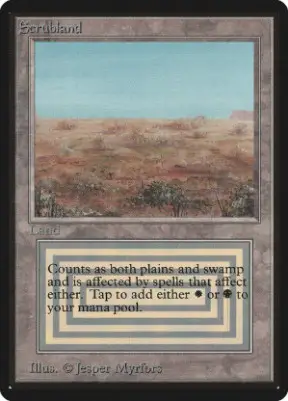
Cards like the original dual lands are perfect examples of this. They have been printed only a few times and their most recent printing was in Revised in 1994. Furthermore, they are extremely powerful lands from a gameplay perspective and see play in a variety of formats.
Their power level and the fact that they were first printed in MTG’s very first set make them highly sought-after by collectors. Couple this with the fact that they are on the reserve list and can never be printed again and you have a perfect storm for high-value magic cards. Here is a look at the TCGplayer market price for the ten Revised dual lands as of 11/28/2022.
| Card | Market Price |
| Badlands | $382.43 |
| Bayou | $450.10 |
| Plateau | $330.23 |
| Savannah | $350.85 |
| Scrubland | $335.96 |
| Taiga | $376.73 |
| Tropical Island | $557.88 |
| Tundra | $482.88 |
| Underground Sea | $748.94 |
| Volcanic Island | $749.72 |
Related: MTG Dual Lands: All Your Questions Answered
How Newly Released Cards Effect Demand
To be highly valuable a card needs to have both high demand and a relatively low supply. One part without the other won’t generate much value. Take a card like Sol Ring for example. It is the single most played card in Commander. The demand for the card is incredible. However, despite this, you can get a copy for around $1.25. This is because Sol Ring has been printed a whopping 38 times.
This goes to show that demand alone cannot drive up card value. The same is also true for supply. Take a card like Water Wurm for example. It has only one printing and that was in August of 1994. It has a scarcity that tends to make cards valuable. However, despite its rarity, the card is worth about a dime simply because people are not buying the card.
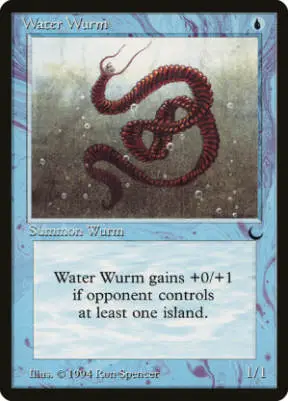
I bring this up because occasionally when new cards come out they give cards with no demand a reason to be played. If that card happens to have a very low print, you suddenly have a recipe for value where there previously was none. This exact thing happened with the release of Kamigawa: Neon Dynasty.
Before Kamigawa’s release, the card Fervent Charge cost around 20 cents. Much like Water Wurm, Fervent Charge only has one printing and was seeing no play. However, when Kamigawa came out it brought with it Isshin, Two Heavens as One, and a reason for people to play a 20-cent card from 2001. It always had scarcity, now it has the demand and the price has gone from 20 cents to $20.
After the surge, the card has since settled down to around $8 but that’s still a massive increase.
Condition
A variable in a card’s value is what condition it’s in. Cards that show signs of wear or damage, such as creases, bends, or marks along the borders will lose some of their value as a result. However, cards that show signs of light wear may still fetch good prices.
This is especially true with very old cards, as cards are expected to have gained some wear over such long periods. Keeping cards in binders or protective card sleeves can help prevent them from being damaged. Sleeving is especially important for preventing foil cards from curling.
Related: The Best Card Sleeves For Mtg And Pokemon Cards
For an example of how the condition affects price, a near mint Force of Will costs around $91 at its low. While a damaged version of the card is $69.20.
Key Takeaways
- Cards with high demand and a low supply are the most valuable
- When a card receives a reprint the increase in supply lowers the price
- Reserve list cards are often valuable since they will never be reprinted
- Cards in good condition are more valuable than those that aren’t
Why Do Banned Cards Go Up In Value?
The short answer is that they don’t. Not usually anyway. However, there have been some small exceptions to this.
For example, when the ban of Oko, Thief of Crowns became imminent, the card lost roughly 50% of its value. However, following the ban in standard, the price went back up. This is because the price drop happened pre-ban when it was unsure which formats the card would receive a ban in. Fearing the worst, players of all formats stopped buying the card. Therefore, the price plummeted.
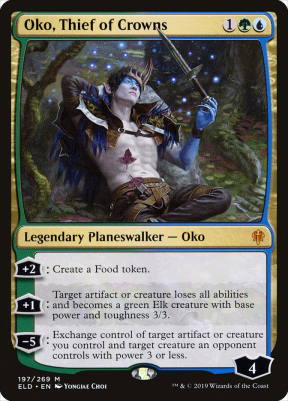
However, Oko was initially only banned in standard. This meant that right after the announcement players of modern, pioneer, and commander began to buy the card again, causing the price to surge. Ultimately, Oko would end up banned in modern, pioneer, historic, and legacy as well. When this happened the price did what was usual and dropped down.
There are cases where a card becoming banned causes other card’s value to increase. This could be seen with the banning of Arcum’s Astrolabe. Astrolabe was so effective at filtering mana that people had to quit playing Blood Moon. As a result, the price dropped. However, without Astrolabe in the format, Blood Moon was effective again and the price went up post-ban.
How To Determine Card Value?
If you have cards that you are unsure about the value of you have a few options. First, you can scan the cards into the TCGplayer app. You simply download the app and then hold your phone above the card and it will tell you the price. Sometimes the app will give you the price for a slightly different version than the one you scanned. So, be sure to be vigilant.
Related: How to Set Up SpellTable for Remote Magic
Secondly, you can look at eBay sold listings for your cards. This will give you a very accurate idea of what your cards could sell for. This is also a great way to get a second opinion after using the TCG app. Next, you could take your cards to your local game store where MTG cards are sold and see if they will assist you in appraising your cards.
I personally use TCGplayer for a quick search of cards and eBay sold listings as a resource if I’m looking to sell the card.
What Are The Top 10 Most Valuable Magic Cards?
To keep this list from being all “Moxes” and dual lands, I have decided to include only the most expensive one of each on the list itself. So, one Mox and one dual. However, I will include the others along with their price underneath the one that makes the list. Furthermore, numbers 10-7 are the most expensive cards that you can purchase for a known price. While numbers 3-1 are some insane one-ofs whose extreme rarity makes them nigh on priceless.
10. Chaos Orb – $15,199.99
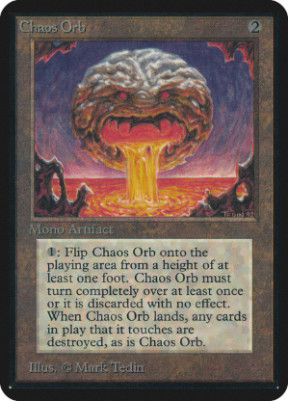
Chaos Orb is a unique card. It was one of the few “dexterity cards” printed in very early sets. Like Chaos Orb, the cards have abilities that require you to throw or flip the card as part card effect. There was supposedly a player that ripped up their Chaos Orb into several pieces so that it would touch more opposing permanents.
This wild story is also the reason for the existence of the card Chaos Confetti.
9. Time Walk – $21,000
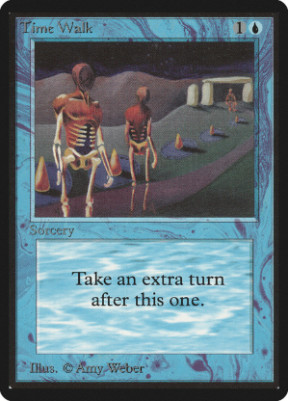
Printed in MTGs very first set, Time Walk is by far the best “extra turn” spell ever printed. It is one of the “power 9” and carries the same massive price tag as the other eight.
8. Underground Sea – $25,000
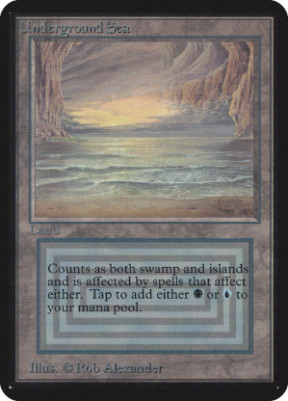
The original dual lands are some of the most powerful lands ever printed. They are highly playable in many formats and highly sought-after by collectors of MTG history and their price certainly reflects it. Here is a look at the other original dual lands (Alpha Printing*) and their prices as of 11/28/22.
- Badlands – $7,600
- Tundra – $7,840
- Tropical Island – $11,200
- Bayou – $6,000
- Taiga – $6,400
- Plateau – $4,719
- Scrubland – $6,000
- Savannah – $6,500
- Volcanic Island – $14,400
*Volcanic Island was left out of Alpha by mistake and as a result, doesn’t have an Alpha printing. The price listed is for the Beta version.
7. Ancestral Recall – $28,000
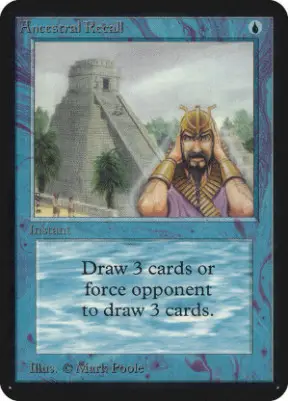
Ancestral Recall is one of the most recognizable cards in the game and with good reason. It is the grandfather of all cantrips and is without a doubt the best one.
6. Timetwister $29,000
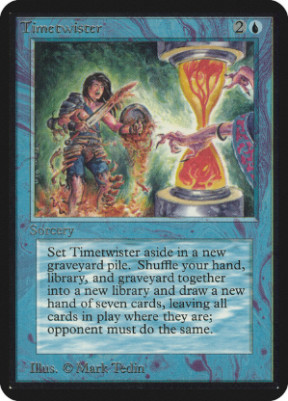
For two generic, and one blue mana both players shuffle their hands and graveyards into their library and draw seven new cards. This is quite a game-changing effect. Therefore, I can see why the oldest versions of the card fetch such high prices.
5. Mox Ruby – $30,000
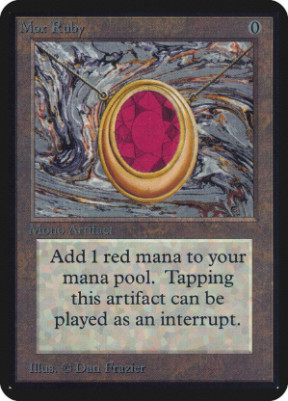
The “Mox” cards, much like the dual lands, will completely take over a value list if you include multiple cards from the cycle. These powerful artifacts were pretty quickly realized to be overpowered, as they are essentially an extra land. As the game’s creatures and spells got better, so did the Mox artifacts. Mox Ruby is the most valuable of the bunch but here is a list of the others if you’re curious about their price.
- Mox Emerald – $12,000
- Mox Jet – $23,000
- Mox Pearl – $18,000
- Mox Sapphire – $27,000
4. Black Lotus – $511,000

Black Lotus is undoubtedly the most iconic card in the history of the game. So much so, that I have come across people who didn’t play the game at all who recognized the card. Its legendary status in the world of MTG, and beyond, will forever be cemented.
With this unrivaled infamy also comes unrivaled value. A PSA Gem-Mint 10, Alpha edition Black Lotus sold for $511,000 in an open auction. This makes it the single most expensive magic card to ever be sold on the open market.
While the numbers are already quite staggering, it seems the price for the card has continued to climb since then. There are a few PSA 9.5 Lotus’ on eBay for around a million and they currently have nearly 1,000 watchers each. I think it is quite likely to see a copy sell for over the $511,000 mark eventually.
3. Proposal
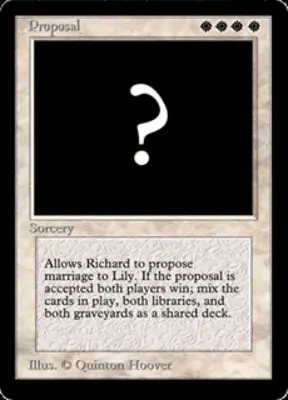
Now we venture into the land of the unknown. Black Lotus is the most expensive card that you can buy but are there cards worth more that simply aren’t for sale? It would seem so. Take the “Proposal” card as an example. Planning to propose to his girlfriend, Richard Garfield approached his MTG team about a card to pop the question with. Thus was born the card you see above.
Garfield put the card in his playtest deck and played with his then-girlfriend until he drew the card. Then he proposed and she said yes. Congrats Mr. and Mrs. Garfield. There were nine copies of the card printed in total and given to the creators and a few family members. With so few of them in existence, if one ever emerged for sale, who knows what price it could fetch.
2. Shichifukujin Dragon
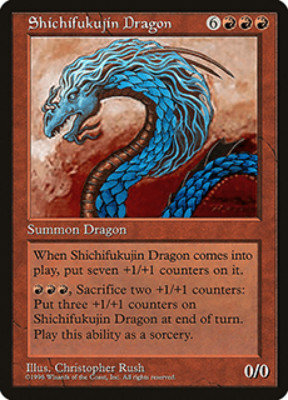
In 1996, Magic was starting to make it to the Asian market where it found great success. As a result of this popularity, construction on the “DCI Tournament Center” started in Tokyo, Japan. Shichifukujin Dragon commemorated the center’s construction and Asia’s love of MTG.
When Richard Garfield gave the green light, a single Shichifukujin Dragon was printed and given to the center. When it eventually closed, the card went to the Hobby Japan Head Office where it still sits today. If this special, single card were to ever be offered to collectors, who knows what it may sell for.
1. 1996 World Champion
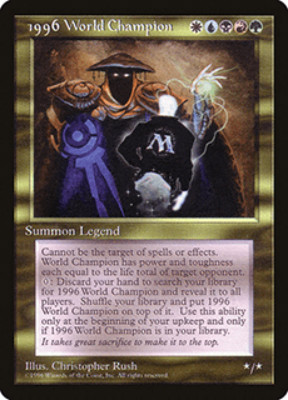
The 1996 World Champion card is the single rarest MTG card ever printed. The card was awarded to Tom Chanpheng after beating Mark Justice. He won despite having to remove all copies of Adakar Wastes from his deck and replace them with basic plains, due to an error when submitting his deck. This meant he was incapable of casting any of the blue cards in his deck for the match. Yet, he still managed to secure a win.
To make the victory that much sweeter, after he received the card, they destroyed the other copies and printing plates during the ceremony. This means the card can never have another printing. Because the printing presses for Shichifukujin Dragon can’t be confirmed to have been destroyed, 1996 World Champion was given the nod for rarity. As a truly one-of-card, it would be a nearly priceless treasure to hardcore Magic: The Gathering investors.
End Step
The ever-fluctuating financial side of MTG cards is a multifaceted thing. However, with an understanding of supply and demand, we can begin to grasp why some cards have value while others don’t. With that said, there are still many small factors that can cause some huge value seemingly out of nowhere. Regardless of why you are interested , I hope this article has given you the tools needed to achieve your goals or ease your curiosity.
